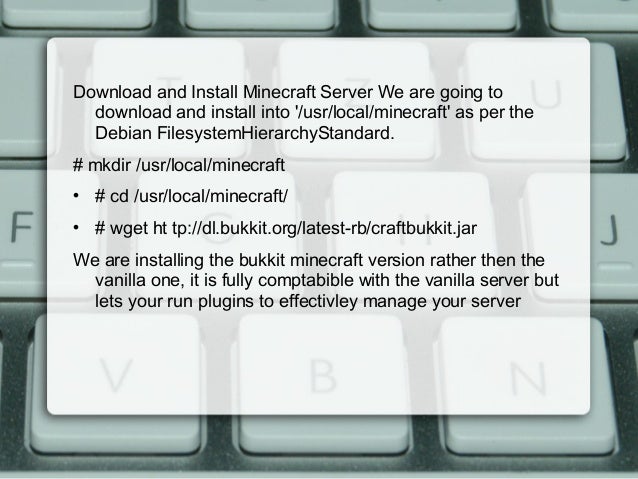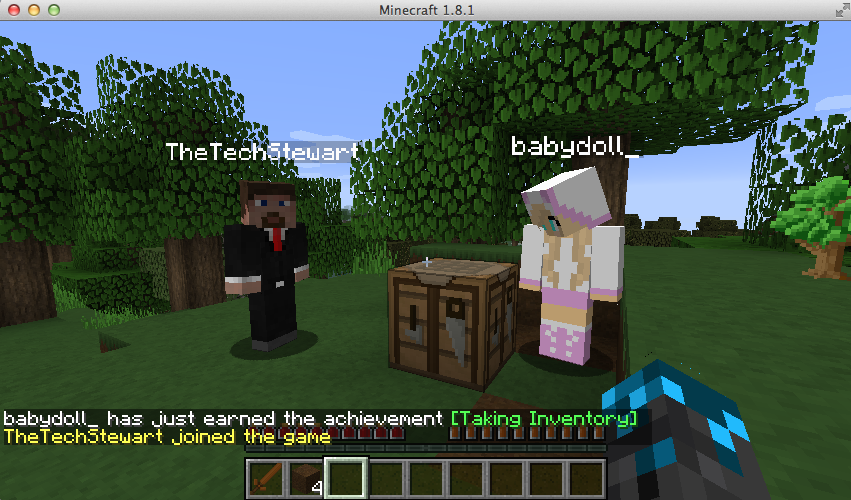Chmod Minecraft
Sooner or later in the Linux world, you will have to change the permission on a file or directory. This is done with the chmod command.
In this article, I’ll share with you some of the practical examples of chmod command. I’ll also explain some the popular terms like chmod 777 or chmod 755 or chmod -r.

Before you see the chmod examples, I would strongly advise you to learn the basics of file permissions in Linux. Using chmod command will be a lot easier once you understand the permissions.
Chmod Russia SireIgnus. 0 + Follow - Unfollow Posted on: Jul 12, 2021. Thank you for visiting MinecraftSkins.com - Skindex, the source for Minecraft skins. # chown root:minecraft bin/useragent # chmod 4550 bin/useragent Please note that the order of these commands is important. Doing the chown afterwards will alter the permissions set using the chmod. No resource display. The multicraft.log shows 'Failed to calculate resource usage'.
Chmod command in Linux
What is chmod? chmod stands for change mode. This command is used for changing the mode of access.

But wait! Is it not meant for changing the permission? Actually, in early Unix days, permissions were called mode of access. This is why this particular command was named chmod.
chmod command has the following syntax:
Before you see how to use chmod, you should know its options.
- -v : output a diagnostic for every file processed
- -c : like verbose but report only when a change is made
- –reference=FILE : use FILE’s mode instead of MODE values
- –R : change permissions recursively
Note that using -v option report if change were made or if nothing needed to be done. When combined with -R option, -v can produce a lot of output. –reference=FILE let you use the current permission mode of FILE as the permissions to set on the target file. Note this option requires a double-dash prefix (–) not (-).
Chmod command examples
Using chmod command is very easy if you know what permissions you have to set on a file.
For example, if you want the owner to have all the permissions and no permissions for the group and public, you need to set the permission 700 in absolute mode:
You can do the same in symbolic mode.
If you want an easy way to know the Linux file permission in numeric or symbolic mode, you can use this chmod calculator. Just select the appropriate permissions and it will tell you the permissions in both absolute and symbolic mode.
Change permission on all the files in a directory recursively
chmod has the recursive option that allows you to change the permissions on all the files in a directory and its sub-directories.
chmod 777: Everything for everyone
You might have heard of chmod 777. This command will give read, write and execute permission to the owner, group and public.
If you want to change the mode to 777, you can use the command like this:
chmod 777 is considered potentially dangerous because you are giving read, write and execute permission on a file/directory to everyone (who is on your system). You should totally avoid it.
chmod +x or chmod a+x: Execution for everyone
Probably one of the most used case of chmod is to give a file the execution bit. Often after downloading an executable file you will need to add this permission before using it. To give owner, group and everyone else permission to execute file:
chmod 755: Only owner can write, read and execute for everyone
This next command will set the following permission on file: rwxr-xr-x. Only the owner will be allowed to write to the file. Owner, group members and everyone else will have read and execute permission.
chmod 700: Everything for owner only
This command will give read, write and execute permission to the owner. Group and others will have no permissions, not even read.
chmod 666: No one executes
To give owner, group and everyone else read and write permission on file.
chmod 644: Everyone can read, only owner can write
With this next one, owner will have read and write while group and everyone else have read permission.
chmod 600: Owner can read and write, nothing else for anyone
With this next one, owner will have read and write while group and everyone else will have no permissions whatsoever.
chmod command examples in symbolic mode
In the above examples, I use bitmask to set the new MODE. Those are easy to calculate. Simple addition is required. Consider the following:
- X = 1
- W = 2
- R = 4
You can now easily see where I got the 755, 666, 640 from. You don’t have to use bitmask to set new permission. A more human readable way is available. This second format looks like this:
While this may seem complicated, it is quite simple. You first start with typing chmod and the OPTIONS that you want. Then, ask yourself: Who am I changing permissions for? User, Group, Others. This will give you the first section of the command:
The next step to complete the command, you either decide to add permissions bits (+), remove permissions (-), or set permission (=). This last one will add or remove permissions as needed to set permission as you requested.
The next section is where you decide the permission MODE to apply(+), remove (-) or match (=). You can specify any combination of rwx.
This next example will apply read/write permission to file for the owner. The verbose option will cause chmod to report on the action.
This next one will set the group’s write permission on directory and all its content recursively. It will report only on changes.
You can combine multiple operation to be done on permission like this next example. It will make sure owner has read/write/execute, also add write permission for group and remove execution for everyone else:
This last one will use rFile as a reference to set permission on file. When completed, the permission of file will be exactly as they are for rFile
There are more options and MODE that can be used with chmod that are not covered or mentioned here. I wanted to keep this to basic and hopefully help a few new Linux user.
A word of warning!
With chmod and sudo you now have to power to change permission on almost any files. This does NOT mean you should. Permissions outside your home directory are set the way they are for a reason. Changing them is rarely the appropriate solutions to any problems.
I hope these chmod command examples were helpful for you. Got a question or suggestion? Please leave a comment below.
Become a Member for FREE
Join the conversation.
Compatibility
Minecraft: Java Edition will run on popular distros as long as the minimum requirements are met.
Install Notes
LinuxGSM installs the vanilla server by default https://minecraft.net/en/download/server. There is currently no method for LinuxGSM to install custom Minecraft servers automatically. Should you wish to install a custom server you will need to manually install the jar file and point LinuxGSM to it.PaperMC and Waterfall MC Server is also available here:https://linuxgsm.com/lgsm/pmcserver/https://linuxgsm.com/lgsm/wmcserver/Minecraft Java Edition now requires Java 16. Currently only Ubuntu 20.04 has this in its official repositorysServer
For consistant uptime it is recomended you host a server in a data center. If you dont already have a server, you can rent a dedicated or vitual server from one of our sponsored providers, OVHCloud, Linode, Vultr.
If the command-line isnt for your you can use GameServerApp web-based game server management service.
Minimum Recommended Distros
Other Distros
Although not tested, any distro with tmux => 1.6 and JRE => 16 should also be compatible withMinecraft: Java Edition servers.Dependencies
Before installing, you must ensure you have all the dependencies required to run mcserver.
Debian 64-bit
EPEL is required to install some dependencies needed for using LinuxGSM on CentOS.
CentOS 64-bit
Gamedig
GameDig is a recommended additional module that allows LinuxGSM to gather more info from the game server such as current map and connected players to be displayed in details and in logs. It also replaces the default LinuxGSM query module in monitor.To install GameDig follow the steps in the LinuxGSM documentation.Install Dependencies Using LinuxGSM
It is possible for LinuxGSM to install dependencies either by having the mcserver user account with sudo access or running the installer as root.user with sudo access
During the installation if the game server user has sudo permissions LinuxGSM will attempt to install any missing dependencies itself.root user
if mcserver is already installed run./mcserver install as root and LinuxGSM will automatically install missing dependencies.Install
From the command-line do the following. Ensuring you have also installed the required dependencies.
1. Create a user and login.For security best practice, ensure you set a strong password. Random password:2. Download linuxgsm.sh.3. Run the installer following the on-screen instructions.
Basic Usage
All Commands
 A complete list of commands can be found by typing.Below are the most common commands available.
A complete list of commands can be found by typing.Below are the most common commands available.Running
start
stop
restart
console
Console allows you to view the live console of a server as it is running and allow you to enter commands; if supported.To exit the console press CTRL+b d. Pressing CTRL+c will terminate the server.
Updating
update
Update checks for any server updates and applies them. The server will update and restart only if required.Debugging
Details
You can get all important and useful details about the server such as passwords, ports, config files etc.
Debug
Use debug mode to help you if you are having issues with the server. Debug allows you to see the output of the server directly to your terminal allowing you to diagnose any problems the server might be having.
Logs
Server logs are available to monitor and diagnose your server. Script, console and game server (if available) logs are created for the server.
Backup
Chmod Minecraft Mod
Backup will allow you to create a complete tar bzip2 archive of the whole server.
Monitor
LinuxGSM can monitor the game server by checking that the proccess is running and querying it. Should the server go offline LinuxGSM can restart the server and send you an alert. You can use cronjobs to setup monitoring.
Configure LinuxGSM
For details on how to alter LinuxGSM settings visit LinuxGSM Config Files page.
Chmod Minecraft Servers
Documentation
For detailed documentation visit the LinuxGSM docs.
Cronjobs
Chmod Minecraft Server
To automate LinuxGSM you can set scheduled tasks using cronjobs, to run any command at any given time. You can edit the crontab using the following.
Below are the recommended cron tasks.
Configure LinuxGSM
Chmod Minecraft Skin
For details on how to alter LinuxGSM settings visit LinuxGSM Config Files page.
Documentation
For detailed documentation visit the LinuxGSM docs.
Command-line not your thing?
Instantly deploy your own Minecraft: Java Edition game server with GameServerApp web-based game server management service.
Either bring your own dedicated server from top providers such as OVH or have GameServerApp provide one for you.
Chmod Minecraft Server
GameServerApp: RconConnect
GameServerApp is a LinuxGSM partner that offer features that compliment existing LinuxGSM game servers.
Using Rcon; control, monitor and automate your Minecraft: Java Edition LinuxGSM game servers from a web browser.
- Easily setup automated RCON actions using the drag-and-drop editor.
- Talk to in-game players or run RCON commands from Discord.
- Track player stats, see online players and when they play.
- Manage players, allowing you to kick and ban or send an in-game items.
- Give other people in your community rcon access.
Add your first 2 LinuxGSM servers for free.
Learn more >